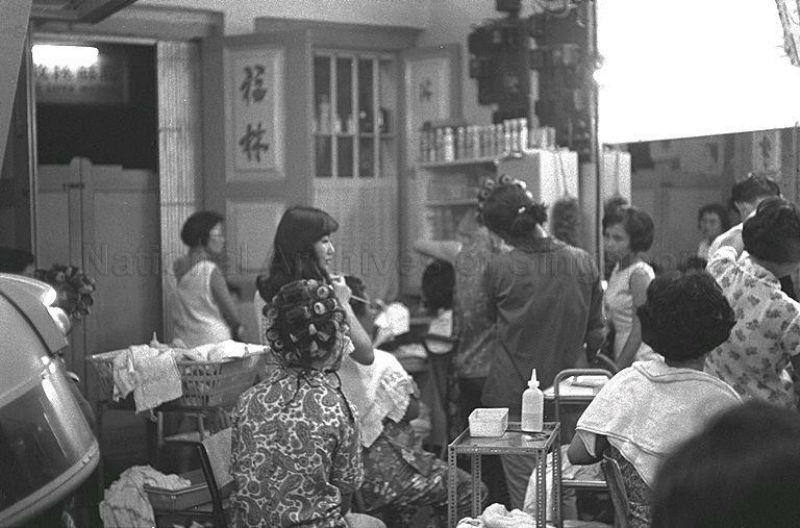It was a tumultuous year – and the last time Singapore would celebrate Chinese New Year as part of Malaysia.
The start of the Year of the Snake fell on February 2, 1965. There had been expectations that Hari Raya Puasa would take place on the same day, but with no sighting of the first moon of Shawwal, it would not come until a day later.
To mark both celebrations, Prime Minister Lee Kuan Yew spoke of the importance of unity in a message published on the front page of The Straits Times. “On this occasion for double rejoicing, I send good wishes to all,” he said. “Amidst all the festivities, the new clothes and the good things to eat, perhaps there is time for reflection on how it is that 11-million Malaysians eat the best and have the most clothes to wear in Asia – not to mention the good roads, public buildings, private housing, telephones, street lights and drinking water.”
He warned that this could not be maintained without constant effort. “We can continue to enjoy all these provided the foundation of this economic well-being is never shaken – provided there is harmony between the races, peace and order in the country and constructive endeavour in a tolerant society.”
His comments could not have been more relevant. The race riots of 1964 were all too fresh in the memory and the country was in turmoil at the height of Konfrontasi – four years of conflict led by Indonesia, who opposed the formation of Malaysia. In March 1965, three people would die in a bombing perpetrated by two Indonesian marines at MacDonald House on Orchard Road.
Lee’s sentiments were echoed by Malaysia’s Deputy Prime Minister Tun Abdul Razak who said that there was “a place for everyone in Malaysia whatever our racial origin may be”. He described the urgent need to stand together against external aggression. “We must forget sectional, communal and provincial interests and must not magnify imaginary or otherwise grievances or injustice at a time when all our efforts and energies should be utilised in consolidating our nation to fight our enemies,” he said.
People on the streets responded well to this call for racial harmony.
Celebrations galore
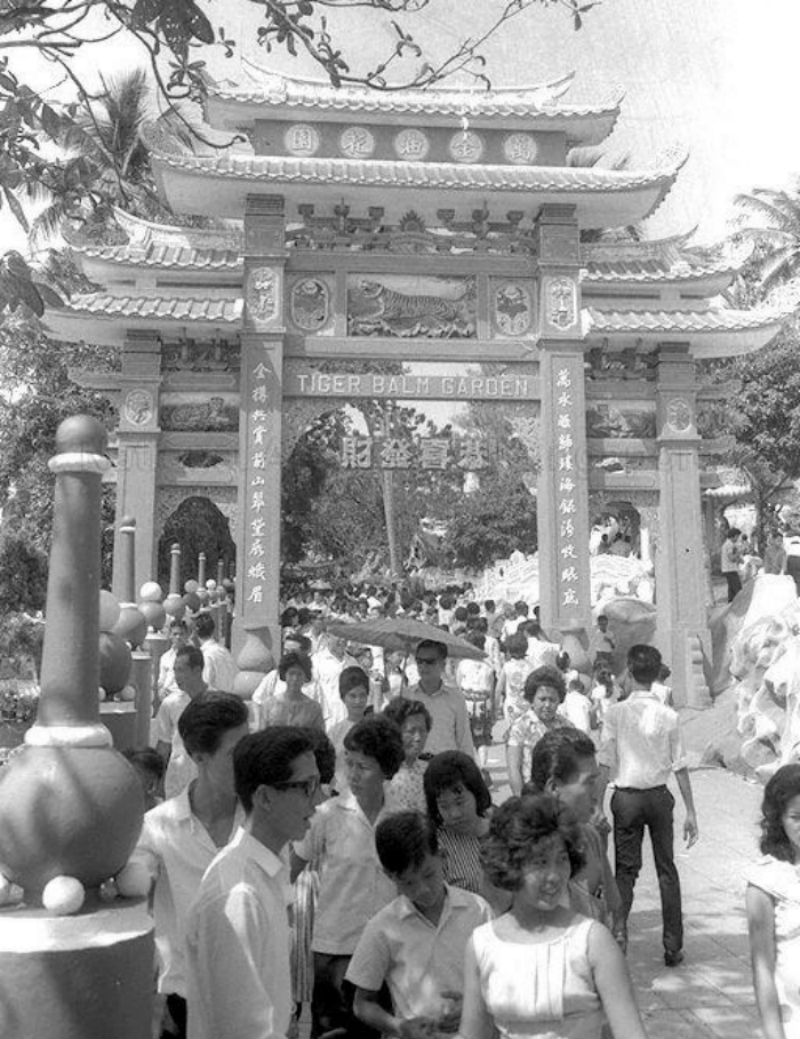
Families headed to the popular attractions of the day – Tiger Balm Garden (now Haw Par Villa) and the Botanic Gardens — and people of all races flocked to Chinatown on shopping trips. Of course, plenty of red packets were handed out to the young ones, filled with even-numbered amounts ranging from $0.20 to $2.
In Kallang, plans were announced for a joint Chinese New Year and Hari Raya Puasa party at the Jalan Tenteram Community Centre – 400 people were expected to attend, with Buang bin Omar Junid, member of the Legislative Assembly for Kallang, as guest of honour. Entertainment was to be provided by lion dancers as well as Chinese, Malay and Indian performers, with Malaysian food on the menu.
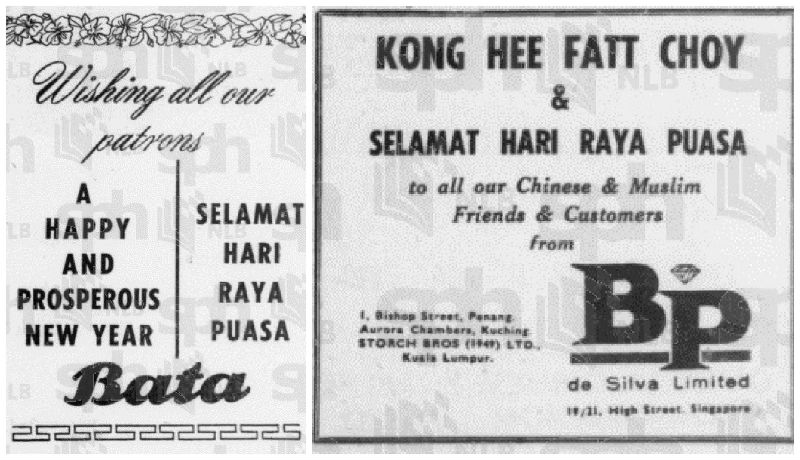
Many companies took out ads in The Straits Times. There were greetings from Bata, jewelers BP de Silva, Oversea-Chinese Banking Corporation, Tasek Cement and a “Selamat Hari Raya Puasa” and “Keong Hee Huat Chye” from Boon Siew Ltd, the sole agents for Honda Motorcycles in Brunei and Malaysia. Pelangi Publications also extended a toast with a special offer for readers. For just $3 you could have Love Letter Writing Improved, the essential guide to penning captivating missives with selections of poetry, proverbs, and quotations along with 153 model letters.
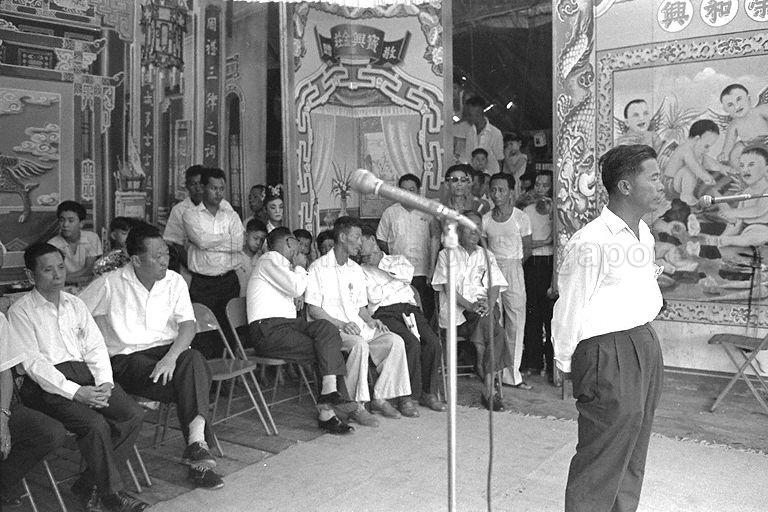
Entertainment went far beyond Chinese operas. As Elvis Presley ruled the cinemas with his musical romantic comedy Girl Happy, the concert crowd was looking forward to Goodwood’s Kong Hee Fatt Choy Show at the Singapore Badminton Stadium, headlined by Manfred Mann, The Kinks and The Dutch Swing College Band. The most expensive tickets? $6.
The Great World Cabaret hit full tilt with “175 beautiful and charming hostesses to choose from” while Celestial Room at Amber Mansions promised free ang pows at their tea dance for the night. On TV Malaysia Channel 5, viewers were treated to episodes of Dennis the Menace, McHale’s Navy and The Twilight Zone.
Showing that some things never change, acting traffic chief ASP Tan Teck Cheng had to caution reveling motorists. “If you drink, don’t drive; if you drive, don’t drink,” he said.
Triumph and despair
The spirit of charity was also in the air in 1965. The feel-good story then was how things were looking up for the eight Ow orphans. They lost their father two weeks before Chinese New Year in 1964 and their mother was killed in a road accident that October. With contributions from readers of The Straits Times and two Chinese dailies, a princely sum of $100,000 was raised for them.
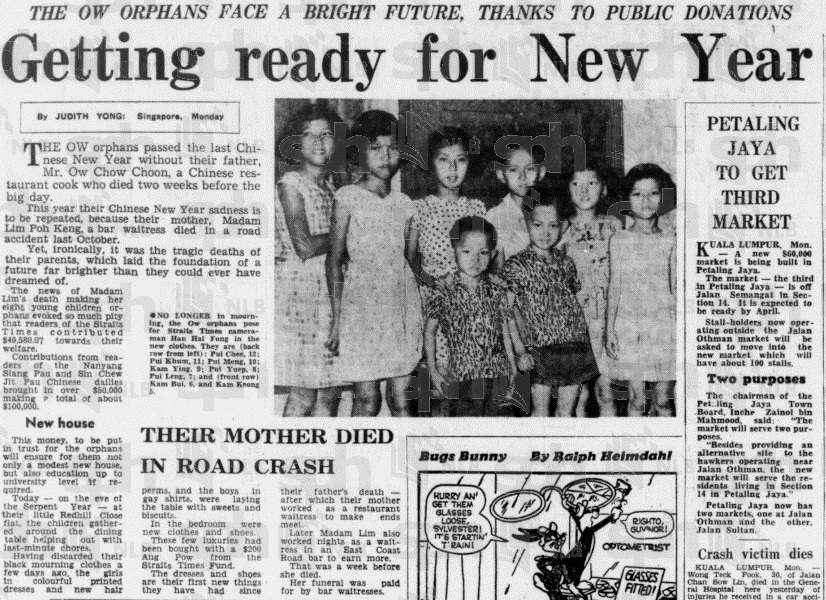
But not everything had a happy ending. More than 70 people became homeless when five attap huts along Upper Thomson Road burned down in blazes caused by firecrackers. Fortunately, no one was killed. Perhaps they should have listened to “S.S.S.”, who wrote in to protest the “New Year din”. “Surely we can usher in the New Year without the din from crackers?” the complainant said. “Thousands of dollars are spent to no useful purpose.”
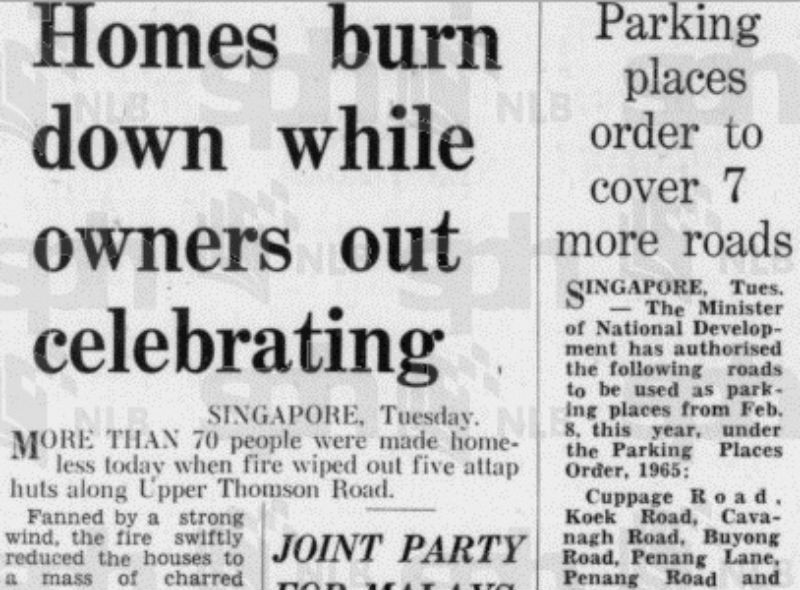
Days of fashion past
Just as nostalgia is always in the air these days, the past was being fondly remembered back then. In her column, “Mainly for Women”, Esme Baptista mulled over the changing ways Chinese New Year was being celebrated — the elaborate affairs of the 1920s replaced by more sophisticated get-togethers like cocktail parties. “Gone are the days when weeks of preparation led to a climax of feasting and rejoicing for several days,” she wrote. “Today’s preparation is cut down to the minimum and the celebration culminates with the main family dinner followed by ang pows.”
She could easily have been talking about the present day.
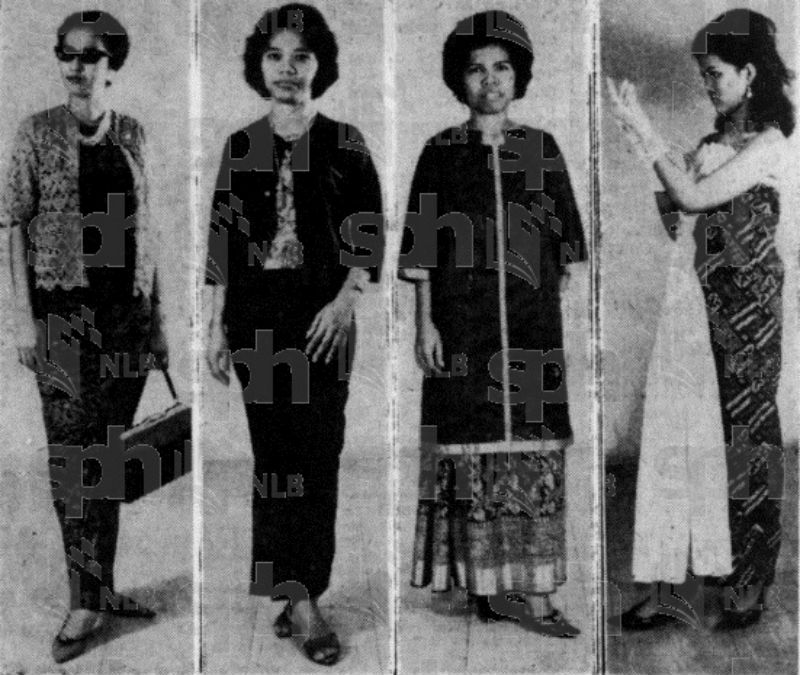
Baptista also provided a rundown of the year’s fashion trends. “Girls, we can relax… skirts are going to remain knee-length, or mid-knee if you like it a little shorter,” she wrote. “But the recent speculation in the fashion world that dresses are going to be above-the-knee length has fizzled out.” Citing shows in Paris by Laroche and Carven, she noted a focus on feminine figures with light, sunny season colours (beige, champagne, pink and pale olive), suits with hip-length jackets and slim, straight skirts, and silk print afternoon dresses with plenty of pleats.
Fashion and beauty were not taken lightly 50 years ago — a visit to the hairdresser was a popular Chinese New Year activity. Ladies would form long queues outside salons, sitting on stools as they waited for their turn to get a $5 perm. Men had it easier: they could just comb back their hair using Tancho pomade.
In the “Mainly for Women” column, four glamorous girls shared the limelight wearing their festive outfits: Norkiah Sahari with a three-piece batik and lace number, Hilal Jaafar with a modern sarong kebaya, Habibah Rahim with a royal blue baju kurong and Edna Tham with a batik evening dress. Tham was happy to admit her adherence to Chinese New Year traditions and made 15 new dresses to wear over the course of the celebration.
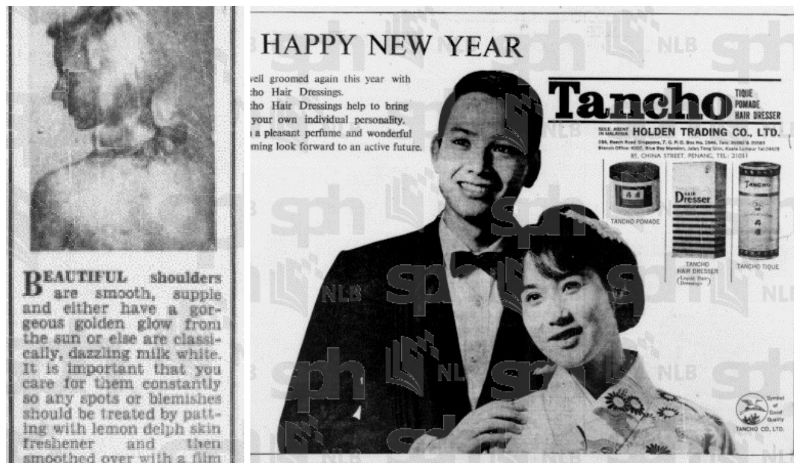
50 years on and Chinese New Year celebrations are going as strong as ever, and since it’s SG50, everything’s scaled up.
Chingay Parade, a mainstay since 1973, will see its grandest staging yet as 11,000 performers take to the F1 Pit Building. The streets of Chinatown have been lit up in red and gold explosions of color and decor, and will continue to dazzle until March. River Hongbao 2015 in turn promises an array of performances, fireworks, a sumptuous feast on its Food Street and its biggest local lantern display ever.
Firecrackers may be long gone folks, but it’ll still be a monumental Gong Xi Fa Cai this year.
Photos: National Archives; Singapore Press Holdings; National Library Board
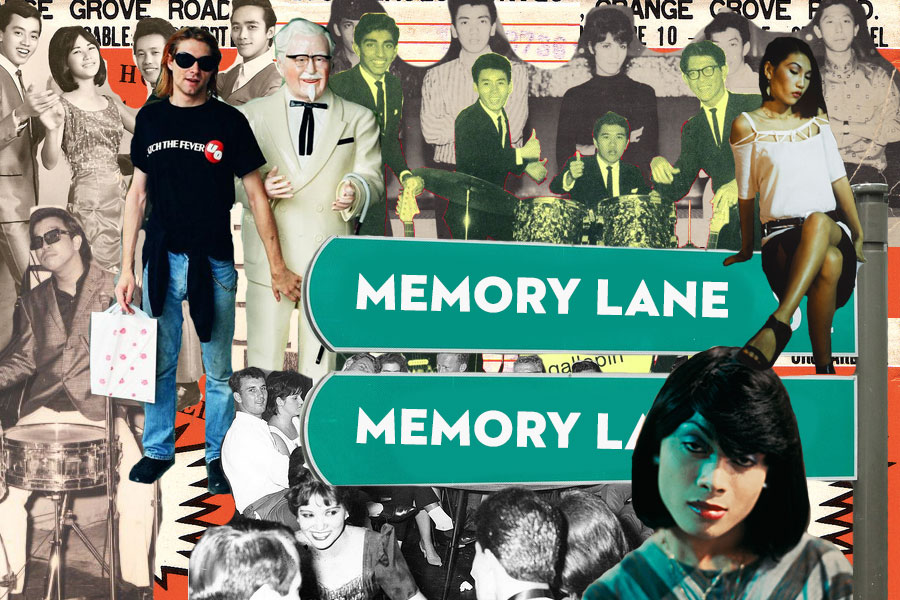
Memory Lane is an original Coconuts Singapore series about the evolution of local culture. Got an idea about something we should pursue? Tweet us.
Read more stories from the Memory Lane series:
Before Zouk there was Golden Venus
Singapore: The land of the living… and dead
